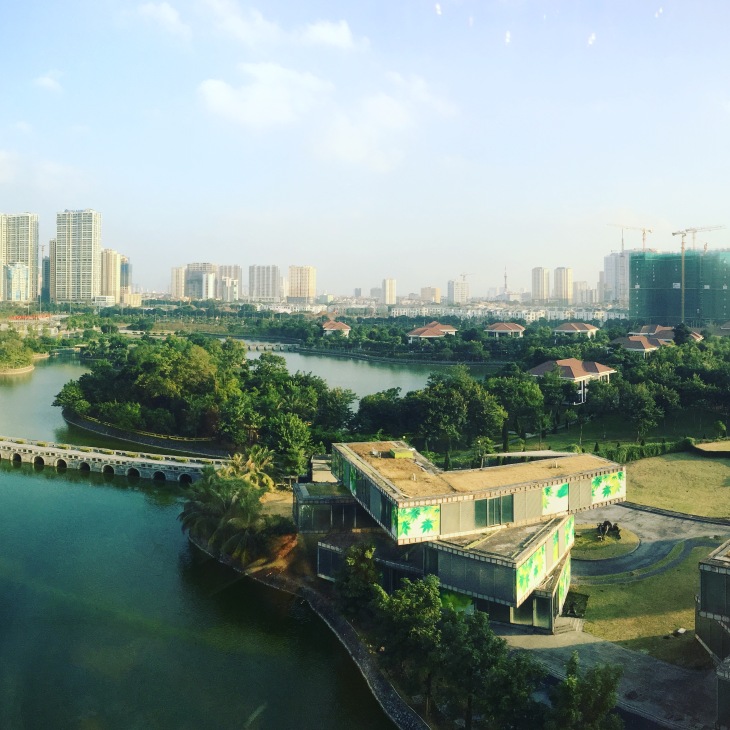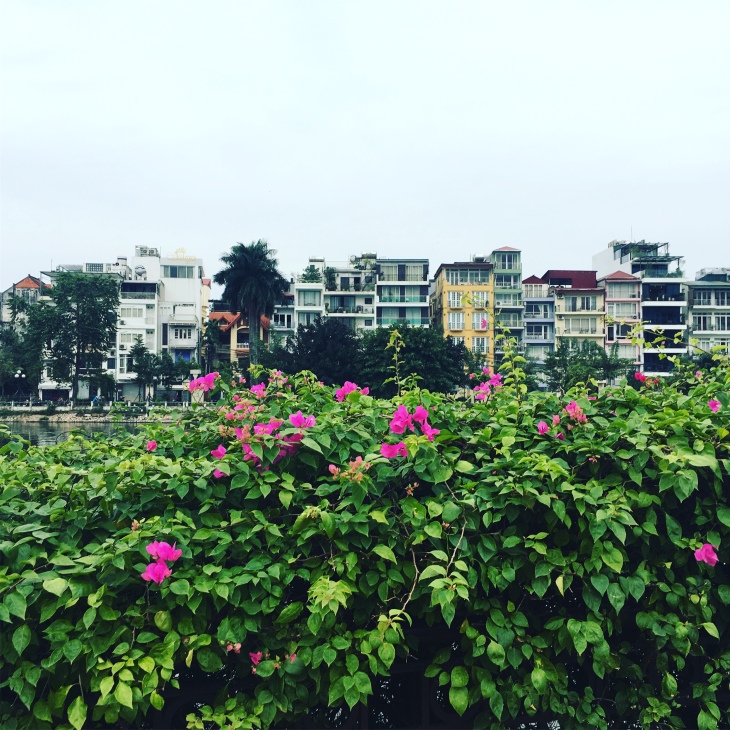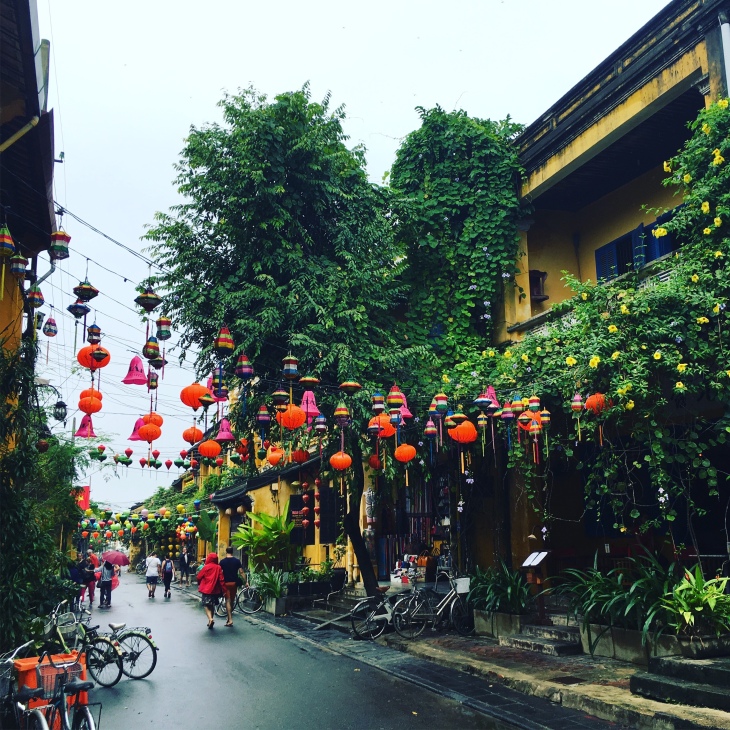My mother, father, and I returned to Hong Kong in late 2017, and then toured Vietnam. The entire city of Hong Kong is under construction. It’s a lively atmosphere. Vietnam presents another picture, though still reaches into the future. In Hanoi and Saigon, we saw glass and steel towers rising, or already finished. In villages, internet cables are being hastily installed. Restaurants and cafés serve the latest Vietnamese delicacies. Grandmothers en route to market carry ducks, chickens, or puppies, in baskets on their bicycles. Water buffalo wade through rice paddies. Dogma often prevails, but people are genuinely interested in foreigners, and the American way of life. They see themselves as progressive socialists, not the degenerating communists the West long portrayed them as.
Vietnam is the 14th-most-populated country, with nearly 100 million inhabitants. The northern part was ruled by China from 111 BC to 938 AD. In that year, Vietnam won its independence, and gradually acquired land in a southward expansion, until 1760, when the whole of Vietnam was united. In the mid-19th Century, France began colonizing Indochina, which included Laos, Cambodia, and Vietnam. The entirety of Vietnam was under French control by 1884. Japan invaded French Indochina in 1940, leading to a famine in Vietnam in 1945. Ho Chi Minh and his comrades fought for independence until 1954. Afterward, French Indochina was dissolved, creating the countries of Vietnam, Cambodia, and Laos. The conflict with America began in 1965, following a decade-long struggle between North and South Vietnam. American troops withdrew in 1973, and the North took over the South, establishing the Socialist Republic of Vietnam, in 1976.
We flew with Vietnam Airlines from Hong Kong to Hanoi, a city of 8 million, in the north of the country. From 1883 to 1945, Hanoi was the administrative center of French Indochina. The French Quarter, constructed during that time, reflects a grand European style, with broad tree-lined avenues, churches, and posh villas. From 1954 to 1976, Hanoi was the capital of North Vietnam, and afterward, the capital of a unified Vietnam. In the Old Quarter, each street historically specialized in a particular trade, fashioning jewelry, silk, tin, or bamboo products. On our arrival, we grabbed a taxi to the futuristic JW Marriott, designed to evoke a dragon, a traditional symbol of Vietnamese culture. It took an hour-and-a-half, and the sluggish traffic tested our patience.

(From JW Marriott Hanoi)
After breakfast the next morning, we met our guide, from Hanoi Free Tours, in the lobby. We headed straight to Ho Chi Minh Museum. Inside, we toured the facility, dedicated to the leader’s life, and plight against imperial powers. Next, we walked to the Old Quarter, slurping pho at a small café. We passed through the French Quarter, the Old Quarter, and around Hoan Kiem Lake, where we learned about the Turtle Tower in the center. We picked up ice cream, and then browsed in the Temple of Literature – devoted to Confucius, scholars, and sages. Built in 1070, it appears on the back of a Vietnamese banknote. Retreating to the hotel, our guide accompanied us to the lounge for soda and snacks.

(Ho Chi Minh’s Stilt House – Hanoi)

(One Pillar Pagoda – Hanoi)
For breakfast the next morning, I dined on smoked salmon, cheese and bread, pastries, jackfruit, and passion fruit. The fixer for our cooking school class met us at the hotel. We shuttled in an Uber to the Old Quarter. Our chef instructor, Rose, guided us to the market, pointing out various fruits, vegetables, herbs, and spices, including turmeric and ginger roots. She carefully selected ingredients for the feast. Back at the small hotel where the class was held, we prepared fried fish stuffed into rice paper, chicken fried rice, and spring rolls. We double-fried the spring rolls, later sampling the fruits of our labor. We dipped the spring rolls, and fish rolls, in a fish sauce amplified by vinegar, sugar, and chilies. Afterward, Rose walked us to Hoan Kiem Lake, where we flagged a taxi. At the hotel, we played cards and drank Vietnamese coffees, with sweetened condensed milk.

(Vegetable Market – Old Quarter Hanoi)

(Cooking class results – Hanoi)
On Saturday, we caught the Marriott shuttle to Hoan Kiem Lake. The streets around the lake were closed to traffic, while kids and parents sauntered through. A few kids zipped by in toy cars. Several groups with a teacher stopped to practice English with us. We continued wandering, past metalworking shops in the Old Quarter. We honed in on Pho Gia Truyen, a nondescript café recommended by Fodor’s. Their pho included thicker slices of beef than our previous tasting. We stopped for a cold drink, and then grabbed a taxi to the Vietnam Museum of Ethnology, where we learned ancillary details on the 54 ethnicities of Vietnam. For the outdoors portion, we passed through huts demonstrating typical village life. We climbed a steep set of stairs, onto a platform with an oversized hut. Mom bought a serving spoon and fork, made of buffalo horns, with silver-plated handles.

(Practicing English in Hanoi)
After checkout the next morning, we taxied to the Old Quarter, to the Ethnic Travel tour office, where an employee checked our passports and visas. We rode toward Halong Bay, stopping for petrol along the way. At Halong Bay, we picked up our guide, Quyet, his assistant, and a couple from Europe. After another hour-and-a-half, we arrived at our boat, in pristine Bai Tu Long Bay. Here the real adventure began. We hopped onboard and set out to sea. The views were breathtaking. We noticed loads of boats in the harbor, but hardly any on the way to our destination, Quan Lan Island. Lunch was delectable – a grilled white fish, shrimp, tofu with peppers and tomatoes, cooked cabbage, chicken on the bone, and rice, served with soy sauce and chili sauce.

(Bai Tu Long Bay – Vietnam)
(Bai Tu Long Bay video)
We captured photos from the deck, as well as up top. The karst outcroppings in every direction marveled. Our guide said 8000 people live on Quan Lan Island. He assured us we would have our own room, with a bathroom, and electricity. At the harbor, Dad, Quyet, Arthur, and I rode bicycles to the homestay. I nearly sideswiped a water buffalo, hidden amongst growth on the side of the road. The ladies jumped in a tuk-tuk, with our luggage. We stopped at a desolate beach, and then arrived in the village. Immediately, I had déjà vu. I remembered the village, the homestay, and patio, from a vivid dream. That evening, we made spring rolls, served with shrimp, an omelet, sweet potato fries, bok choy, peanuts, and bananas. Upstairs, I thanked the gods for wi-fi.

(Beach on Quan Lan Island)

(Quan Lan Island morning market)
Dad went to market early the next morning, and recalled squirming sea creatures, and hair being torched off cuts of pork. Breakfast was delicious, and included crepes with honey and granulated sugar, local bananas, watermelon, fresh-squeezed lime juice, and strong coffee. We rode a tuk-tuk to the harbor, boarding the same boat with the same crew as our outbound trip. A soldier noted our presence. Quyet and his assistant accompanied us to the mainland. We took an alternate route, but still encountered infinite karst outcroppings. We had the option to kayak, but rain deterred us. The cook served lunch, and then we arrived in the harbor. We bused back to Hanoi, arriving at the Intercontinental Westlake. I researched the ongoing typhoon in Hoi An, our next destination.

(Bai Tu Long Bay return trip)

(Westlake neighborhood – Hanoi)
At the airport the next day, Dad’s bag was searched because of the serving spoon and fork. The officers thought they were weapons. Alas, they looked at him, perceiving no real threat, and ushered us through. At Danang Airport, we found our driver. Flooding was visible on the plane approaching Danang, and now we saw it up close. The driver practiced his English, describing resorts along the beach, and pointing to where roadblocks stood when Trump was recently in town. Entering Hoi An, a city of 120,000, and a UNESCO World Heritage Site, the landscape and habitation changed. The town seemed verdant, and quaint, for its size. Traffic was tame. At River Palm Villas, we surveyed the manicured grounds before checking in. The agent brought a birthday cake out for Mom, as requested in advance. That evening, we taxied to Old Town, dining at the Green Mango. We brought the cake along. I had a spicy red curry with broccoli, cauliflower, carrots, mushrooms, and chicken, served over rice. Afterward, we moseyed through Old Town, photographing the scene. Water had flooded a few streets.

(Hoi An Old Town)
A barking dog kept Mom awake all night. Roosters and construction further ensured our day started early. Breakfast, at $3 per person, was a steal. I had coffee and pastries, mango, flan with honey, and a banana pancake. We taxied to Old Town, browsing and looking for a coffee shop. A shopkeeper pointed out the water line on her shop’s walls. Rain lightly fell. We crossed over the Thu Bon River, passing more shops, and then stopped at Ms. Vy’s Kitchen & Deli. Crossing the river again, we walked past the Japanese Covered Bridge. We stopped at Coco Box, a coffee shop Dad had read about. He and I drank Vietnamese iced coffees, and Mom had jasmine tea. The rain came down with intensity now. We returned to Ms. Vy’s for a snack, and a milkshake for me. At the hotel, I decompressed with a deep tissue massage, and then we dined in. I ordered grilled beef with onions, green peppers, and spicy, red peppers, along with rice, and a mango lassi. Back at the room, we prepared for Saigon.

(Japanese Covered Bridge – Hoi An)

(Thu Bon River – Hoi An)
After breakfast, we set off for the airport. The same driver who delivered us to Hoi An returned us to Danang Airport. He drove too fast, weaving in and out of traffic. Touching down in Saigon, we taxied to the Park Hyatt. The French colonial architecture, lobby, and furnishings dazzled. The air outside felt hot and humid so I changed into shorts, sandals, and a t-shirt. We walked to Le Fenetre Soleil, a funky restaurant with an ornate bar, serving Indonesian, Vietnamese, and Western food. We dined on Indonesian dishes. I had chicken with a chili sauce, over rice, along with a lime juice. Fresh tomatoes and cucumbers cut the spiciness.
Saigon, also known as Ho Chi Minh City, is the largest city in Vietnam, with more than 12 million residents in the metro area. In 1929, it had a population of 124,000. It grew at a prodigious pace, but also expanded boundaries. In 1949, it became the capital of South Vietnam, and in 1975, it fell to the North Vietnamese. Saigon now has over 80 universities and colleges, with more than 400,000 students. It feels more Western and modern than Hanoi.
On Friday, we walked to Ben Thanh Market. Our guide arrived late, sweating and flushed, with apologies and a timid request that we wait while she parked her motorbike. Inside, we examined the market. It was filled with clothes and trinkets, but included fish and meat sections. Our guide assured us Ben Thanh is for tourists, but she could take us to a local market, with more action. However, it wasn’t particularly appealing either, so we walked onward, past the Saigon Skydeck, along the Saigon River, and up to the Rex Hotel, where US troops drank at the rooftop bar during the war. We browsed in Rehahn Art Gallery, deciding we would return for prints. We passed down Book Street, closed to traffic, with storefronts and stands occupying the street. We stopped at the Central Post Office to visit with Duong Van Ngo about his life translating Vietnamese into English and French for soldiers and locals. He rides his bicycle to the Post Office each day, offering his services for 50 cents per page. He was eager to visit with Americans, demonstrating his skill with English.

(Chatting with Duong Van Ngo at the Central Post Office in Saigon)
Later, we toured the War Remnants Museum. Our guide waited outside, as required by her organization. We looked through photos from the conflict, taken by US journalists, framed, and on display. Another section showed the effects of Agent Orange, including a deformed, stillborn baby, preserved in formaldehyde. Outside we looked at tanks and helicopters, including a US Army Huey, and then peered inside Tiger Cages, where North Vietnamese kept political prisoners. A bit shaken, we departed, connected with our guide, and asked for a pho recommendation. She pointed across the street to a small café. We dined on Bun bo Hue, a beef noodle soup similar to pho. I refreshed with mango juice. We strolled past the Reunification Palace, and then returned to the hotel. For dinner, we taxied to Chopsticks Saigon. Black Friday ensured traffic hardly moved. I ordered a peach-mango smoothie, and sampled the fried sea bass.

(Notre Dame Cathedral – Saigon)
On Saturday, Mom and Dad returned with a bagel, croissant, and coffee. We cut up a mango from the room. We sauntered to the Reunification Palace, or Independence Palace, exploring the imposing structure. On the top floor, windows peered onto a helicopter pad. A ballroom, meeting rooms, and lavish offices occupied the main floors. In the basement, an extensive bunker included rooms with strategic maps. Next, we returned to Rehahn Art Gallery, purchasing canvases and postcards of iconic Vietnamese scenes. After checking out, we taxied to the Renaissance, along the Saigon River. The atrium, lounge, and rooms felt passé, but the views from our room, and the rooftop pool, were impressive. The lobby seemed refined, and the breakfast spread in the restaurant was tasty.

(Saigon River from Renaissance Saigon)
We taxied to the Saigon Zoo and Botanical Gardens the next morning. The enclosures were claustrophobic, but I recalled the importance of educating youth, firsthand, about flora and fauna, especially kids trapped in sprawling cities. Afterward, Dad and I passed through the Museum of Vietnamese History. We ate lunch in a café near Rehahn Art Gallery. I had a tuna sandwich, with homemade potato salad. Mom and Dad purchased laptop bags for me and my brothers-in-law. The following morning, we flew with Cathay Pacific to Hong Kong, and then on to San Francisco.

(Saigon Zoo & Botanical Gardens)
I won’t hesitate to visit Vietnam again. The people are accommodating, polite, and proud of their homeland. Though we enjoyed the food, it was alarming to see puppies headed to market. So too, hearing the shrill screams of a pig one night discomforted me. Bai Tu Long Bay defied words, and Hoi An is a splendid, and preserved, artist’s village, though inundated with rain and floodwaters on our visit. Sapa, in the mountains of northern Vietnam, was the only location I felt we missed. Cathay Pacific delivered another superb experience. Asia is vast, and we touched a small segment on this excursion. As always, I hope to return, with tales of new places and people. Until then, keep wandering, soaking in new sights, and if you find yourself at a cozy café in Hoi An, reading this, or reflecting upon it, consider the role travelers play in connecting the world. We build bridges, and then steadily cross, bringing stories from the locales we encounter. Enjoy those moments.

(San Francisco to Denver – Virgin America flight)
Thank you for this report. I’ve bookmarked it – would love to do something like this in the future. Think my husband, the reluctant traveler, would enjoy it. Would have loved a little more detail about your guide/companies or sources you used for your trip.
Enjoyable read for sure!
Thanks for taking a look! I appreciate it. Let me know if you need any help planning a trip to Vietnam.
Thank you for the offer. Won’t happen for a year or more (have plans set for trips prior to that). But if you have any sources to provide, would love to know.
Sounds like you and your parents had a fantastic time. I like the mix of high-low kind of style that you used.
We’ve never been to Asia, but Vietnam has interested us for some time, and would probably be the place we want to go first.
I highly recommend Ethnic Travel. They took us from Hanoi out to Bai Tu Long Bay. They have tours all over the country. We read about them in the Wall Street Journal.
Thanks! I’ll check them out and bookmark them.
Much appreciated.
Happy future travels.
Thank you. Same to you!
Hi! The photo you captioned with ‘HCM stilt house’ is actually a replica of the One Pillar Pagoda. And the photo above that might be the actual stilt house. 🙂
I’ve been in Hanoi for more than a month for work. Unfortunately I have not yet ventured outside the city. Hopefully I could visit Hoi An and Saigon soon before going back to my country. 🙂
Thank you! I’ve made appropriate changes. Hoi An is a special place, and Saigon is full of history. Both are worth your time. Enjoy!
Matthew—I love reading about that trip. What an experience, indeed!
Thanks for helping make it happen!